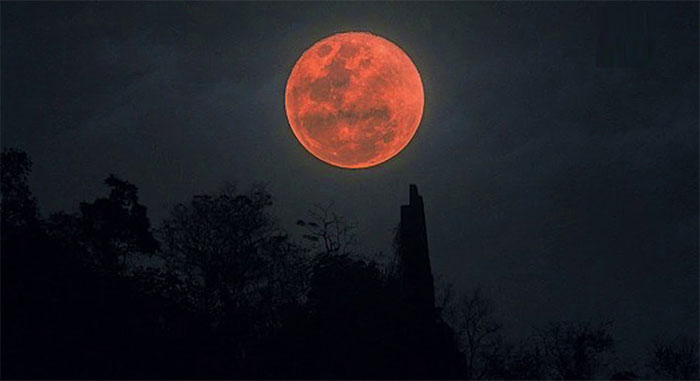The phenomenon of the supermoon and total lunar eclipse occurring simultaneously on May 26 is the most anticipated astronomical event of the year in Vietnam.
On the evening of May 26 (the full moon of the fourth lunar month), astronomy enthusiasts will have the opportunity to witness the second supermoon of the year. The moon will be fully illuminated by the sun and will be closer to Earth than a typical full moon. During this upcoming supermoon, the moon will appear about 14% larger and 30% brighter when observed from Earth.

When observed from Earth, the moon will appear about 14% larger and 30% brighter.
This supermoon is also known as the Flower Moon, a name given by Native American tribes, as it marks the time of year when spring flowers bloom abundantly. It is also referred to as the Corn Planting Moon because this is when farmers typically begin their planting season. Another name for it is the Milk Moon.
This is the second supermoon out of three supermoons in 2021. The final supermoon of the year will occur on June 25.
An interesting fact is that this second supermoon coincides with a total lunar eclipse – the most exciting astronomical event that can be observed in Vietnam this year. A lunar eclipse occurs when the moon, Earth, and sun are perfectly aligned. The moon enters the Earth’s shadow (Umbra) and is completely obscured, gradually turning a deep red color, which is why this phenomenon is also known as a blood moon.
Locations to Observe the Supermoon and Total Lunar Eclipse in Vietnam
This lunar eclipse lasts over 5 hours, starting at 3:47 PM when the moon enters the Earth’s penumbral shadow and turns a light red, reaching its maximum at 6:18 PM when the moon is at the center of the dark shadow and turns deep red. The total lunar eclipse lasts for about 7 minutes, after which it transitions to a partial eclipse, then a penumbral eclipse, and ends at 8:49 PM.
This lunar eclipse can be observed over a vast area including the Pacific Ocean, Eastern Asia, Japan, Australia, and Western North America.
In Vietnam, part of this lunar eclipse can be observed. However, the observation times may vary across different provinces and cities.
- The southern provinces can observe the eclipse the earliest, around 6 PM.
- In Da Nang and other central provinces, the eclipse can be observed starting at 6:10 PM.
- Hanoi and northern provinces can observe it from around 6:30 PM.
However, it will be easier to observe the phenomenon across the country only after around 6:30 PM when the moon rises above the horizon alongside the constellation Scorpius. Unlike a solar eclipse that requires specialized observation equipment, a lunar eclipse can be viewed with the naked eye, and it is clearer if you have a telescope or binoculars. Observers should face east and choose a location that is open, free from light pollution, and dust.
Observing the blood moon tonight depends heavily on weather conditions. According to the National Center for Hydro-Meteorological Forecasting, northern provinces and coastal areas from Thanh Hoa to Thua Thien Hue can observe this event due to clear skies and little rain tonight. However, southern provinces, the Central Highlands, and coastal areas from Da Nang to Khanh Hoa are experiencing prolonged heavy rain with cloudy skies, making observation more challenging. Observers should closely monitor the weather conditions in their area to see if they can follow this exciting astronomical event.
Unlike a solar eclipse, which requires special equipment for observation, a lunar eclipse can be seen with the naked eye. Observers should choose a spacious, open area with minimal streetlights and dust, and may use binoculars or a telescope for a clearer view.




















































